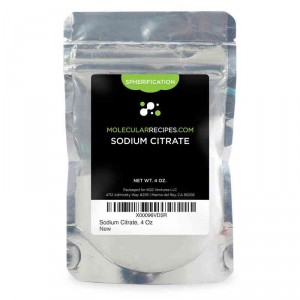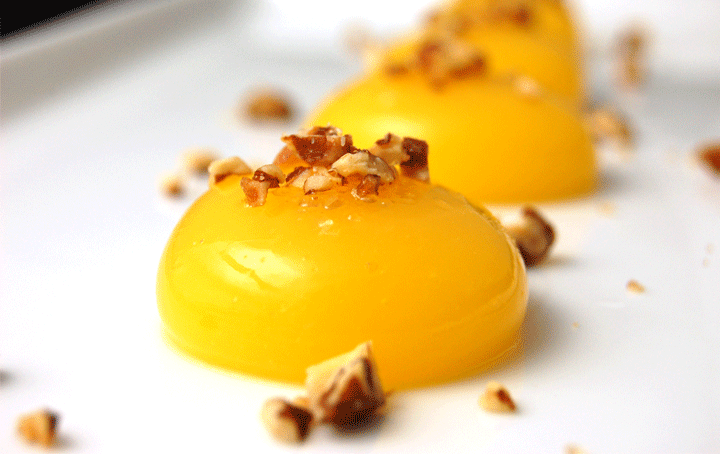Sodium Citrate (Citras)
Sodium citrate has a surprisingly large number of different uses, given its relatively simple chemistry. Sodium Citrate most commonly appears as the salt trisodium citrate and can be used as an emulsifier, calcium sequestrant, acidity regulator, and preservative. In molecular gastronomy sodium citrate is widely used in spherification to regulate acidity and reduce calcium content to prevent early gelation. Sodium citrate is also used as an emulsifier to make constructed cheese, a smooth and melty cheese but with the flavor of aged cheese.
Sodium Citrate Origin
 There are three types of sodium citrate: monosodium citrate, disodium citrate, and trisodium. Most sodium citrate used for food is the trisodium form. Sodium is the weak conjugate base of citric acid. Essentially, if you remove the H+ portion of citric acid and replace it with Na+ ions, you get sodium citrate.
There are three types of sodium citrate: monosodium citrate, disodium citrate, and trisodium. Most sodium citrate used for food is the trisodium form. Sodium is the weak conjugate base of citric acid. Essentially, if you remove the H+ portion of citric acid and replace it with Na+ ions, you get sodium citrate.
For practical purposes, this means that sodium citrate has long been an important chemical for use in the chemistry lab. As a conjugate base to citric acid, it serves to buffer changes in acidity. In other words, when sodium citrate is present in a solution, it will require more acid than normal to change to decrease the pH of that solution. This is a useful trait, as it makes it easier to make fine adjustments in acidity.
Sodium Citrate Function
In addition to buffering pH (reduce acidity), the citrate ion in sodium citrate also acts as a sequestering agent. This means that the citrate ion is likely to bind with other ions that are present in a solution---particularly calcium. In cheese, the calcium ions in cheese's casein milk proten are replaced with sodium ions. When this happens, the casein changes structure and exposes both water-loving and oil-loving ends. The casein, then, is the emulsifier, even though sodium citrate is considered an emulsifying salt.
Sodium citrate's sequestering abilities are important in molecular gastronomy as well. Sodium Alginate, Low Acyl Gellan, Low-methoxyl Pectin and Iota Carrageenan only gel in the presence of ions such as calcium. But these ions also difficult the proper hydration of the hydrocolloids which is necessary to form a gel. If the liquid to be used for hydration contains natural calcium ions, it is necessary to use a sequestrant like sodium citrate to bind those ions and enable proper hydration. Spherification is one application.
Spherification occurs when a hydrocolloid reacts with calcium and forms a thin skin. Sometimes, however, two much calcium can be present in the mixtures involved, usually due to naturally-occurring calcium in tap water. Sequestrants like sodium citrate are used to reduce calcium and prevent early gelation. They are particularly useful for this purpose since they can also slightly increase pH, which can help the basic spherification process.
Sodium Citrate Applications
We use sodium citrate in this classic Spherical Mango Ravioli recipe by Ferran Adria and the el Bulli team to help regulate the pH of the mango sphere and to sequester excess calcium.
Another recipe popularized by Modernist Cuisine is their version of modernist mac 'n cheese in which they use sodium citrate to give normal cheese the texture of smooth processed cheese but with the complex and intense flavor of your favorite original cheese. This is called constructed cheese in modernist cuisine. This is based on the chemistry developed by James L. Kraft, who in 1916 patented the first American cheese slice. He discovered that sodium phosphate keeps the water and fat droplets mixed when the cheese is melted. The sodium citrate can be used to replace the sodium phosphate and produces the same emulsifying effect to make melty cheese. Aged cheeses tend to separate and become a greasy mess when melted but the sodium citrate helps make the emulsion stable.
Sodium Citrate Properties
Temperature: Will dissolve in liquid water of any temperature, though solubility decreases with temperature.
Texture: Sodium citrate has no texture by itself, but it will change the structure of cheeses to become creamy.
Appearance: Sold as white granules, much like table salt.
Flavor release: N/A
Freeze / Thaw stable: N/A
Syneresis (weeping): N/A
Shearing: N/A
Hysteresis: N/A
Interactions and Tolerance of Sodium Citrate
PH Tolerance: Adding sodium citrate to a neutral solution will slightly increase the pH of the solution, making it more basic. However, it's most important quality is its ability to buffer a solution - that is, to make a solution more resistant to changes in pH. Sodium citrate can buffer solutions in approximately the pH 3.0 to 6.3 range.
Synergies with other ingredients: Sodium citrate is an important calcium sequestrant used for spherification. Calcium works with hydrocolloids like sodium alginate and gellan to form thin films around liquid ingredients. Sometimes, however, too much calcium causes the hydrocolloids to clump prematurely. Sodium citrate traps excess calcium ions, allowing the hydrocolloids to disperse and hydrate without clumping.
How to use Sodium Citrate
Concentration Range: It's difficult to give an exact concentration range for using sodium citrate because the ideal concentration depends on the other ingredients in a recipe. Use with moderation because Sodium Citrate is sour and salty and will affect the flavor of your preparation.
For cheese emulsification, Modernist Cuisine calls for a scaling of 4% sodium citrate by mass to 100% cheese. To make cheese slices use 3.3% of sodium citrate with 1.5% iota carrageenan and 0.5% kappa carrageenan. Use semi hard or hard cheeses such as Guyere, Stilton, Emmental, Comte, Muenster.
As a sequestrant you may have to use between 0.07% to 0.4% depending on the liquid and the concentration of hydrocolloid. For example, according to Modernist Cuisine, a 0.3% LA Gellan solution solution with hard water requires 0.2% sodium citrate, while with bottled drinking water it requires only 0.12%.
For spherification, the amount of sodium citrate depends on the amount of calcium ions naturally occurring in the liquid you are trying to sequester. We have had success using a scaling of 0.25%, but try increasing the concentration if you still get clumps and decreasing the concentration if the spheres do not form.
As a buffer, the effectiveness of sodium citrate depends on the concentration and type of acid being used. Try using sodium citrate in a concentration of half the acid being buffered, then adding acid or sodium citrate as needed. That is, if a recipe calls for 1% citric acid, start with 0.5% sodium citrate.
Dispersion: N/A
Hydration: N/A
Setting: N/A




 (3 votes, average: 4.00)
(3 votes, average: 4.00)

